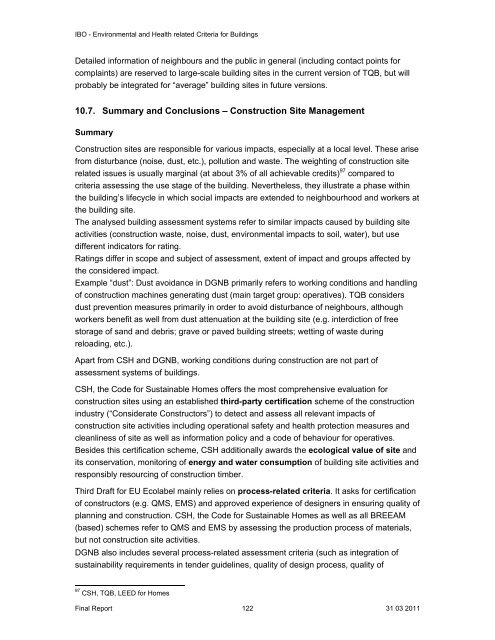Environmental and health related criteria for buildings - ANEC
Environmental and health related criteria for buildings - ANEC
Environmental and health related criteria for buildings - ANEC
You also want an ePaper? Increase the reach of your titles
YUMPU automatically turns print PDFs into web optimized ePapers that Google loves.
IBO - <strong>Environmental</strong> <strong>and</strong> Health <strong>related</strong> Criteria <strong>for</strong> Buildings<br />
Detailed in<strong>for</strong>mation of neighbours <strong>and</strong> the public in general (including contact points <strong>for</strong><br />
complaints) are reserved to large-scale building sites in the current version of TQB, but will<br />
probably be integrated <strong>for</strong> “average” building sites in future versions.<br />
10.7. Summary <strong>and</strong> Conclusions – Construction Site Management<br />
Summary<br />
Construction sites are responsible <strong>for</strong> various impacts, especially at a local level. These arise<br />
from disturbance (noise, dust, etc.), pollution <strong>and</strong> waste. The weighting of construction site<br />
<strong>related</strong> issues is usually marginal (at about 3% of all achievable credits) 97 compared to<br />
<strong>criteria</strong> assessing the use stage of the building. Nevertheless, they illustrate a phase within<br />
the building’s lifecycle in which social impacts are extended to neighbourhood <strong>and</strong> workers at<br />
the building site.<br />
The analysed building assessment systems refer to similar impacts caused by building site<br />
activities (construction waste, noise, dust, environmental impacts to soil, water), but use<br />
different indicators <strong>for</strong> rating.<br />
Ratings differ in scope <strong>and</strong> subject of assessment, extent of impact <strong>and</strong> groups affected by<br />
the considered impact.<br />
Example “dust”: Dust avoidance in DGNB primarily refers to working conditions <strong>and</strong> h<strong>and</strong>ling<br />
of construction machines generating dust (main target group: operatives). TQB considers<br />
dust prevention measures primarily in order to avoid disturbance of neighbours, although<br />
workers benefit as well from dust attenuation at the building site (e.g. interdiction of free<br />
storage of s<strong>and</strong> <strong>and</strong> debris; grave or paved building streets; wetting of waste during<br />
reloading, etc.).<br />
Apart from CSH <strong>and</strong> DGNB, working conditions during construction are not part of<br />
assessment systems of <strong>buildings</strong>.<br />
CSH, the Code <strong>for</strong> Sustainable Homes offers the most comprehensive evaluation <strong>for</strong><br />
construction sites using an established third-party certification scheme of the construction<br />
industry (“Considerate Constructors”) to detect <strong>and</strong> assess all relevant impacts of<br />
construction site activities including operational safety <strong>and</strong> <strong>health</strong> protection measures <strong>and</strong><br />
cleanliness of site as well as in<strong>for</strong>mation policy <strong>and</strong> a code of behaviour <strong>for</strong> operatives.<br />
Besides this certification scheme, CSH additionally awards the ecological value of site <strong>and</strong><br />
its conservation, monitoring of energy <strong>and</strong> water consumption of building site activities <strong>and</strong><br />
responsibly resourcing of construction timber.<br />
Third Draft <strong>for</strong> EU Ecolabel mainly relies on process-<strong>related</strong> <strong>criteria</strong>. It asks <strong>for</strong> certification<br />
of constructors (e.g. QMS, EMS) <strong>and</strong> approved experience of designers in ensuring quality of<br />
planning <strong>and</strong> construction. CSH, the Code <strong>for</strong> Sustainable Homes as well as all BREEAM<br />
(based) schemes refer to QMS <strong>and</strong> EMS by assessing the production process of materials,<br />
but not construction site activities.<br />
DGNB also includes several process-<strong>related</strong> assessment <strong>criteria</strong> (such as integration of<br />
sustainability requirements in tender guidelines, quality of design process, quality of<br />
97 CSH, TQB, LEED <strong>for</strong> Homes<br />
Final Report 122 31 03 2011
















